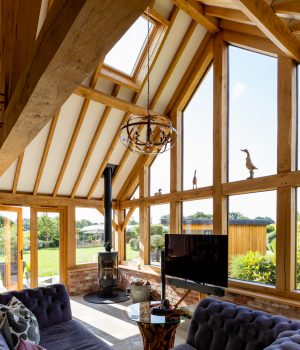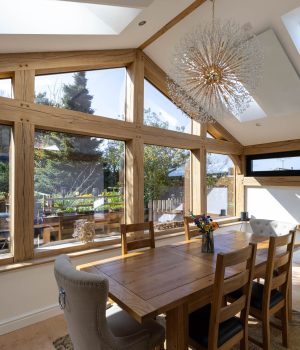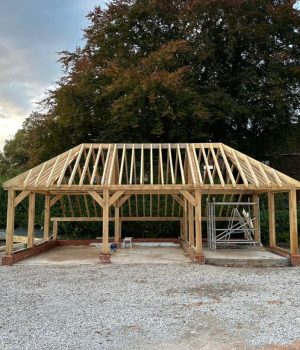Can You Use Planed Oak Timber Outside? (Spoiler: Yes – Here’s Why)
One of the most frequent questions we hear is: Can you use planed timber outside? In short, absolutely. In fact, planed oak timber is one of the best choices for outdoor construction. Whether you’re building a garden structure, cladding an exterior wall, or laying a deck, planed oak provides the durability and appearance many homeowners and tradespeople are after.
Can Planed Timber Be Used Outside?
Yes, planed timber – especially oak – can be used outdoors with confidence. While planing creates a smoother, more refined surface, it doesn’t compromise the timber’s natural qualities. Oak, in particular, is naturally resistant to moisture, insects, and decay. This means it doesn’t require chemical treatment to survive the British climate.
The only noticeable change you’ll see over time is cosmetic. Exposure to sunlight causes oak to take on a beautiful silvery tone, which many people love for its rustic charm.
Why Oak Is Ideal for Outdoor Use
Hardwoods like oak are far more resilient than softwoods when exposed to the elements. Softwoods tend to absorb moisture, leading to rot and fungal growth if not treated. They also require chemical preservatives, which have a bigger environmental footprint.
Oak, on the other hand:
- Naturally resists rot, pests, and fungal attack
- Doesn’t need chemical preservatives
- Weathers beautifully without compromising strength
- Is long-lasting, even in the UK climate
Benefits of Planed Oak Timber
Aesthetic Appeal
Planed oak timber has a clean, smooth surface that highlights the wood’s natural grain. It gives a modern, refined finish to garden structures and cladding. Its uniform profile makes it perfect for contemporary extensions while still showcasing the warmth of a traditional material.
Safer for Use
Unlike rough sawn timber, planed oak has no splinters. It’s the ideal choice for areas where people might touch or brush against the surface – such as handrails, decks, or seating.
Ready to Work With
Planed timber is easier and quicker to install. Since it’s already smoothed and shaped, there’s no need for sanding. This not only saves time but also ensures cleaner joins and flush finishes for flooring, cladding, or garden furniture.

Types of Planed Oak Timber
The type of planing you choose depends on how visible the timber will be and your budget. Here’s a breakdown:
PAR (Planed All Round)
All four sides of the timber are planed smooth. This option is best where every side will be visible, such as support posts in gazebos or cladding panels. It’s also the most expensive, as it requires the most preparation.
PSE (Planed Single Edge or Planed Square Edge)
Only one face – typically one of the wide sides – is planed. This is ideal for decking or cladding where only one surface will be seen. It’s more affordable than PAR while still giving a clean appearance where needed.
PBS (Planed Both Sides)
Here, both wide faces are planed but the narrow edges are left rough. This is often used for visible flooring in verandas or balconies, where the sides are hidden. It’s a good cost-effective option when edge finish isn’t necessary.

How to Treat Planed Oak for Outdoor Use
Oak doesn’t require treatment to last outside, but you may want to apply a finish depending on the look you prefer.
Keeping the Natural Colour
To keep oak looking fresh and golden:
- Apply a clear wood preservative
- Follow with two coats of UV protection oil
This blocks UV rays in the same way sunscreen works for skin. Be aware that even clear finishes can slightly darken the tone. Testing with a little water first can give a preview of the final shade.
Protecting Silvered Oak
If you like the silvered look but want to add protection:
- Apply a coat of clear preservative
- Follow with several coats of Tung oil
This won’t stop UV greying but will protect the surface from moisture and minor staining.
Fixing Blackened Oak
Rain or fungi can sometimes leave black marks on outdoor oak. To clean this:
- Scrub with a fungicidal wash
- Apply wood reviver gel (often contains oxalic acid)
As this is a chemical treatment, always follow the manufacturer’s safety advice and wear protective gear.
Final Thoughts: Should You Use Planed Timber Outside?
Yes – planed oak timber is an excellent choice for external use. It’s low-maintenance, beautiful, and naturally long-lasting. Whether you’re building an extension, a pergola, or cladding an outbuilding, planed oak gives you style and substance in one.
Want advice on the best type of planed oak for your project? Contact us and we’ll be happy to help.




